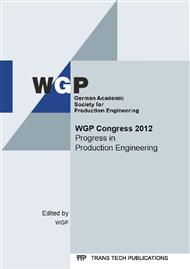[1]
H. v. Rosenberg, Vorstellung eines lnertialen Messsystem für die medizinische Ganganalyse, in Internationales Forum Mechatronik, begleitend zur Motek (2008), Stuttgart, (2008).
Google Scholar
[2]
J. Haug, New chances for highly integrated electric drives, in Medtec Innovation Forum 2010, Stuttgart, (2010).
Google Scholar
[3]
Össur, Februar 2012. [Online]. Available: http: /www. ossur. de/Pages/7062.
Google Scholar
[4]
L. Milde, Technik muss Menschen dienen - Innovationen bei Beinprothesen, In: Gesundheitsprofi (2000), Bd. Nr. 05/2000, pp.21-23, Mai (2000).
Google Scholar
[5]
Össur , Rheo Knee, [Online]. Available: www. ossur. de/pages/16231. [Zugriff am 31 März 2012].
Google Scholar
[6]
Frost&Sullivan, U.S. Lower Extremity Prosthetics Markets N 132 - 54, Frost and Sullivan, Palo Alto (USA), (2007).
Google Scholar
[7]
Medi, OM8, [Online]. Available: http: /www. medi. de/patient/produkte/beinprothetik/medi-gelenke/medi-om8. html. [Zugriff am 31 März 2012].
Google Scholar
[8]
Streifeneder ortho. production GmbH, 3A16 Modular-Kniegelenk-Edelstahl rostfrei-, " [Online]. Available: http: /www. gmbh. streifeneder. de/index. php, id=259&tx_mslogicinfoorder_pi1[showUid]=34564&cHash=2c9cfbac86. [Zugriff am 31 März 2012].
Google Scholar
[9]
S. G. Gissurarson, The power knee - The first active knee, in Medtec Innovation Forum 2010, Stuttgart, (2010).
Google Scholar
[10]
R. L. Waters, J. Perry, D. Antonelli und H. Hislop, Energy cost of walking of amputees: the influence of level of amputation, In: The Journal of Bone & Joint Surgery (1976), Bd. Nr. 58, pp.42-46, Januar (1976).
DOI: 10.2106/00004623-197658010-00007
Google Scholar
[11]
B. Budaker, K. Philipp, N. Parspour und U. Schneider, Model Based Design of Drive Systems for Active Driven Prostheses and Orthoses, in Technicallly Assisted Rehabilitation TAR 2011, 3rd European Conference, Berlin, (2011).
Google Scholar
[12]
A. Gottlob, Differenziertes Krafttraining: mit Schwerpunkt Wirbelsäule, München: Urban & Fischer, (2001).
Google Scholar
[13]
M. P. Murray, A. Drought und R. C. Kory, Walking Patterns of Normal Men, In: The Journal of Bone and Joint Surgery, Nr. 46, pp.335-360, (1964).
DOI: 10.2106/00004623-196446020-00009
Google Scholar
[14]
C. Kirtley, Clinical Gait Analysis, 1. Hrsg., Churchill Livingstone, (2006).
Google Scholar
[15]
K. Fuest und P. Döringer, Elektrische Maschinen und Antriebe, 5 Hrsg., Braunschweig/Wiesbaden: Friedrich Vieweg & Sohn Verlagsgesellschaft GmbH, (2000).
Google Scholar
[16]
J. M. Donelan, Q. Li, V. Naing, J. Hoffer, D. Weber und A. Kuo, Biomechanical Energy Harvesting: Generating Electricity During Walking with Minimal User Effort, In: Science, Bd. 319, Nr. 5864, pp.807-810, (2008).
DOI: 10.1126/science.1149860
Google Scholar
[17]
J. Perry, Norm und Pathologie des menschlichen Ganges, München Jena: Urban & Fischer Elsevier, 1992, (1992).
Google Scholar
[18]
B. Budaker, Actively Driven Prostheses - The Need for New Drive Concepts, in Medtec Innovation Forum 2010, Stuttgart, (2010).
Google Scholar
[19]
B. Budaker, Methodics in product development I: Grey box approach in prosthetic drive design, in Medtec Innovation Forum 2012, Stuttgart, (2012).
Google Scholar
[20]
Y. Akao, QFD: Quality Function Deployment - Integrating Customer Requirements into Product Design, New York: Productivity Press, (2004).
Google Scholar
[21]
B. Rohrbach, Kreativ nach Regeln - Methode 635, eine neue Technik zum Lösen von Problemen, Absatzwirtschaft, pp.73-76, 1 Oktober (1969).
Google Scholar
[22]
C. Zangmeister, Nutzwertanalyse in der Systemtechnik, Berlin: Wittemann, (1970).
Google Scholar
[23]
B. Budaker, Actively Powered Prostheses and Orthoses – The Need for New Lightweight Drive Concepts, in Design of Medical Devices Conference, Minneapolis, (2011).
Google Scholar
[24]
C. Schweizer, Modellierung des Energieflusses einer aktiv angetriebenen Beinprothese mittels Zustandsraumdarstellung, Stuttgart, (2011).
Google Scholar
[25]
S. Baldursson, Bldc motor modelling and control - a matlab/simulink implementation, Göteborg (S), (2005).
Google Scholar
[26]
B. Budaker, P. Budaker, U. Schneider und O. Schwarz, Optimierung des Angriffshebels in aktiv angetriebenen Prothesen, in BMT 2010, 44. DGBMT Jahrestagung 3-Länder-Tagung D-A-CH, Rostock, (2010).
Google Scholar
[27]
B. Budaker, T. Feiler und L. Hovy, Aktive Prothese mit Kegelstirnradgetriebe,. Deutschland Patent DE 10 2011 116 751. 3, 20 24 (2011).
Google Scholar
[28]
H. Hee und A. Wilkenfeld, User-adaptive control of a magnethorheological prosthetic knee, In: Industrial Robot: An International Journal (2003), Bd. Nr. 1, Nr. 3, pp.42-55, (2003).
DOI: 10.1108/01439910310457706
Google Scholar
[29]
K. Yuan, J. Zhu, Q. Wang und L. Wang, Finite-State Control of Powered Below-Knee Prosthesis with Ankle and Toe, In: Preprints of the 18th IFAC World Congress (2011), pp.2865-2870, August / September (2011).
DOI: 10.3182/20110828-6-it-1002.03064
Google Scholar
[30]
H. v. Rosenberg, B. Budaker und M. Barho, Realtime gait phase detection with an inertial measurement unit for lower limb prostheses, in BMT 2011 45. DGBMT Jahretagung (2011), Freiburg, (2011).
Google Scholar


